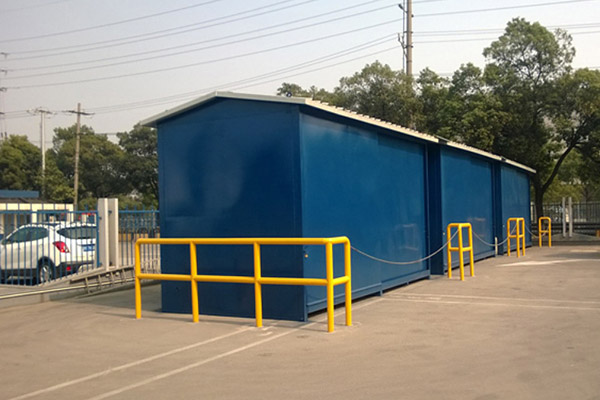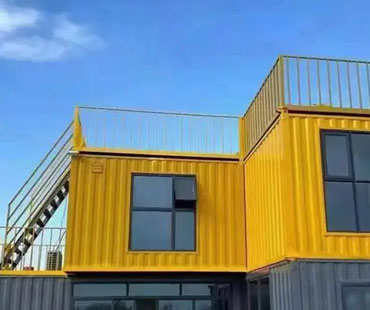In the modern world, shipping containers have evolved far beyond their original purpose of transporting goods across seas and continents. Today, they are increasingly used in construction projects, temporary storage solutions, and emergency rescue operations. Their modularity, durability, and flexibility make them ideal tools for addressing a wide range of logistical and infrastructural challenges. This article explores the multifaceted applications of containers in these contexts, highlighting their advantages, design considerations, and practical impact.
1. Containers in Construction: Modular and Sustainable Building Solutions
The construction industry has seen a dramatic shift towards modular and prefabricated structures. Shipping containers have emerged as a key component in this transformation due to their standardized dimensions, structural integrity, and ease of assembly.
1.1 Modular Construction Advantages
Containers are inherently modular, with standardized dimensions such as 20-foot and 40-foot lengths, making them easy to stack and combine. This allows architects and engineers to design multi-story buildings, temporary offices, and even residential units with precision and speed. Compared to traditional construction, container-based structures reduce construction time significantly. Sections can be prefabricated offsite and assembled on location, minimizing on-site labor costs and disruptions.
1.2 Sustainability and Eco-Friendly Practices
Using containers in construction also promotes sustainable building practices. Repurposing retired or used containers reduces waste, lowers the demand for raw construction materials, and contributes to a circular economy. In addition, container buildings can be insulated, ventilated, and fitted with energy-efficient windows and solar panels, transforming them into environmentally friendly living or working spaces.
1.3 Practical Applications
Container-based construction is not limited to temporary structures. Many projects have successfully integrated containers into permanent buildings, such as student dormitories, office complexes, and retail spaces. Their structural rigidity allows them to withstand harsh environmental conditions, including high winds and heavy loads, making them a versatile solution for urban and rural development alike.
2. Containers for Temporary Storage: Efficient, Secure, and Adaptable
Another common application for containers is temporary storage. Their robust design, lockable doors, and weather-resistant construction make them ideal for safeguarding goods in a variety of scenarios.
2.1 On-Site Construction Storage
Construction sites often require secure storage for tools, equipment, and materials. Containers provide a cost-effective and mobile solution. Unlike traditional storage sheds, containers can be relocated as needed, allowing contractors to adapt to changing site layouts or project requirements. Their steel construction ensures protection against theft, vandalism, and weather damage, while the standardized size facilitates inventory management.
2.2 Industrial and Commercial Storage
Businesses also use containers for short-term storage during seasonal peaks or renovation projects. Industries ranging from retail to manufacturing benefit from containers as temporary warehouses. Their ability to integrate with forklifts and cranes streamlines loading and unloading processes, enhancing operational efficiency.
2.3 Disaster Relief and Humanitarian Storage
In emergency scenarios, such as natural disasters or conflicts, containers serve as rapid-deployment storage units for relief supplies, medical equipment, and essential goods. Their stackable design allows aid organizations to maximize limited space, while durable construction ensures that supplies remain safe from environmental hazards.
3. Containers in Emergency Rescue: Rapid, Resilient, and Reliable Solutions
Beyond construction and storage, containers have become essential tools in emergency rescue operations. Their durability, portability, and adaptability make them ideal for supporting rapid response initiatives in times of crisis.
3.1 Mobile Command Centers and Medical Units
In large-scale emergencies, containers can be converted into mobile command centers, field hospitals, or quarantine units. Their solid steel frame provides security, while internal retrofitting allows for power, water, and climate control systems to be installed. This makes containers a practical choice for temporary operational hubs, especially in remote or disaster-affected areas.
3.2 Disaster Relief Shelters
After natural disasters such as earthquakes, hurricanes, or floods, there is often an urgent need for temporary shelter. Containers can be quickly deployed to provide safe, durable housing for displaced populations. They can be stacked, arranged, or modified with windows, doors, and insulation to create livable spaces within hours, offering a significant advantage over conventional tent-based solutions.
3.3 Logistics Support in Crisis Zones
Containers also play a critical role in the storage and transport of emergency supplies. Medical kits, food, water, and equipment can be safely stored in containers and transported to crisis zones using trucks, trains, or ships. Their robust construction ensures that supplies are not damaged during transit, while their modularity allows aid organizations to optimize storage and distribution strategies.

4. Design Considerations for Containers in Specialized Applications
While containers are versatile, certain design considerations enhance their suitability for construction, storage, and emergency applications.
Insulation and Climate Control: For use as offices, housing, or medical units, containers often require thermal insulation and ventilation systems to maintain a comfortable or safe interior environment.
Structural Modifications: Cut-outs for doors, windows, or ventilation systems must be carefully reinforced to maintain structural integrity. Engineers often add steel beams or frames to compensate for removed sections.
Mobility and Deployment: Containers intended for emergency use may include features such as forklift pockets, crane-ready corners, or modular connectors for rapid assembly and relocation.
Security and Safety: Locking mechanisms, fire-retardant coatings, and corrosion-resistant materials protect contents and occupants, particularly in high-risk environments.
By incorporating these features, containers can be adapted to meet the specific demands of diverse applications, ensuring functionality, durability, and safety.
5. Advantages of Container-Based Solutions
The widespread adoption of containers in construction, temporary storage, and emergency rescue is due to several inherent advantages:
1.Durability: Steel construction ensures long-lasting performance and resistance to environmental stressors.
2.Modularity: Standardized dimensions allow for stacking, linking, and flexible layout designs.
3.Mobility: Easy transport via truck, train, or ship enables rapid deployment to new locations.
4.Cost-Effectiveness: Repurposed or prefabricated containers often cost less than traditional construction or storage solutions.
5.Rapid Deployment: Containers can be quickly set up on-site or in disaster zones, reducing response time and operational delays.
These benefits collectively make containers a preferred solution across multiple industries and scenarios.
6. Future Trends and Innovations
The role of containers is continuing to evolve with technological advancements. Smart containers equipped with IoT sensors can monitor temperature, humidity, and security in real-time. Modular container systems are being integrated into urban planning and temporary infrastructure projects. Sustainable materials and green technologies, such as solar panels and rainwater collection systems, further enhance their environmental benefits.
In emergency management, modular container systems are expected to play an increasingly critical role in disaster preparedness, offering scalable, resilient, and adaptable solutions for global humanitarian efforts.
From construction sites to disaster zones, shipping containers have proven their versatility, durability, and practicality. Their modular design allows for rapid assembly and flexible deployment, while their steel construction provides reliable protection for both people and goods. As temporary storage units, containers ensure the security and organization of critical materials. In emergency rescue operations, they serve as mobile command centers, medical units, and disaster relief shelters, addressing urgent logistical challenges with efficiency and resilience.
With ongoing innovations in design, insulation, digital monitoring, and sustainability, containers are set to play an even more significant role in construction, temporary storage, and emergency response. Their adaptability, cost-effectiveness, and rapid deployability make them indispensable tools in modern infrastructure, logistics, and humanitarian operations, demonstrating that a simple steel box can become a powerful solution in a complex, fast-moving world.


